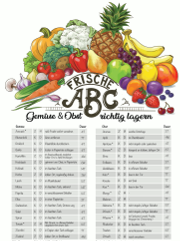Picked pineapples no longer ripen
Is there an aromatic pulp under the skin of the pineapple you bought? The secret will be revealed at the latest after peeling, but then it could be too late. In contrast to some exotic fruits, the degree of ripeness of the pineapple remains unchanged after being picked.
- Fruit does not ripen during storage
- therefore only buy ripe fruit
- Consume quickly after purchase
- after a long “waiting time” the fruit will spoil
- often invisible from the outside
also read
- Store pineapples correctly - this will keep them longer
- Harvesting and sowing pineapple seeds - this is how it works
- Can pineapples ripen?
Recognize ripe fruit with certainty
The quality at the time of purchase determines the later enjoyment. A ripe pineapple shows the following characteristics:
- a pleasant, sweet fragrance
- The shell yields slightly under pressure
- the inner leaves peel off easily
The tool for peeling
To remove the peel from a pineapple fruit, you will need the following kitchen utensils:
- a large, clean cutting board
- a large saw knife
- a small, sharp knife
- possibly. a pineapple cutter
This is how you go about peeling
- Lay the pineapple fruit flat on the cutting board.
- Remove with the Saw knife the green tuft of leaves, while at the same time cutting a 1 cm thin slice from the fruit.
- Cut a slice from the other end as well.
- Line up the pineapple so that one of the cut surfaces is on the board.
- Hold the fruit with one hand so it doesn't slip away.
- Start peeling by placing the knife on top and cutting off part of the peel downwards. Peel generously, the peel can be 5 mm thick.
- In this way, remove the peel from all of the fruit, one after the other.
- Poke out the remaining "brown eyes" with a small, sharp knife.
- With a pineapple cutter you can cut out the hard inside of the pineapple. You can also divide the pineapple into four and cut out the hard, fibrous part with a sharp knife.
- Now all that's left is usable pulp that you can cut into smaller pieces as needed.
Tips
Even if the peel is inedible, it does not have to be thrown away. A fruity-sweet tea can be made from it.
Place the pineapple on the bowl
You can also remove the skin from a pineapple so that the pulp can then be served on it.
- cut off the bottom of the fruit
- Set up the fruit and cut into four lengthways
- Separate the pulp from the skin
- use a long, pointed knife
- Make a deep cut all around between the skin and the pulp
- Cut the pulp into 1 cm wide slices
- Leave on the bowl and serve with it
Just leave the shell on
If a pineapple is cut into small pieces as an edible decoration for cocktails or desserts or is used for snacking from the hand, it does not necessarily have to be peeled beforehand. On the contrary, with the peel each pineapple piece looks more interesting and is easier to hold on to while eating.
Of course, the fruit must be washed thoroughly beforehand. It is also an advantage if the pineapple comes from organic cultivation, as otherwise harmful substances could possibly get into the drinks or beverages. Food can reach.
Conclusion for quick readers:
- Quality: does not ripen; buy ready to eat; peel and consume quickly
- Maturity characteristics: aromatic fragrance; slightly yielding shell; Leaves can be loosened
- Required utensils: Large cutting board; large saw knife, small pointed knife
- Step 1: Cut the top of the leaves and one slice from each side
- Step 2: straighten the pineapple; hold on with one hand
- Step 3: Cut the shell in strips from top to bottom with sawing movements
- Tip: A delicious tea can be made from the shell of an organic pineapple
- Alternatively: cut off the lower end; Cut the fruit lengthways into four; Remove the pulp
- Serving: cut the pulp into slices and place on the bowl
- Do not peel: only cut fruit into pieces for decorative purposes; possibly. Nibble off the pulp

The garden journal freshness-ABC
How can fruit & vegetables be stored correctly so that they stay fresh as long as possible?
The garden journal freshness ABC as a poster:
- as free PDF file to print out on your own
